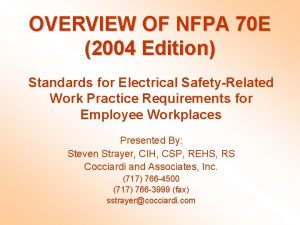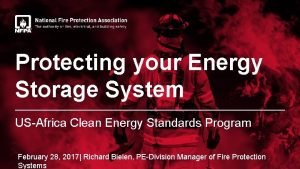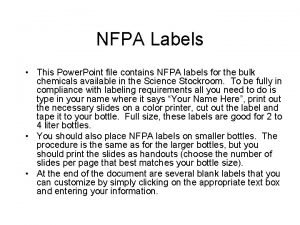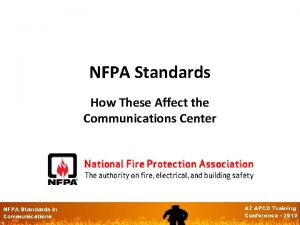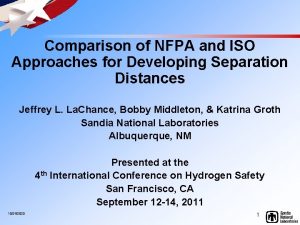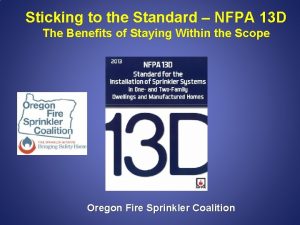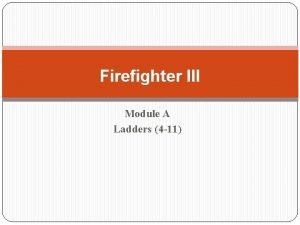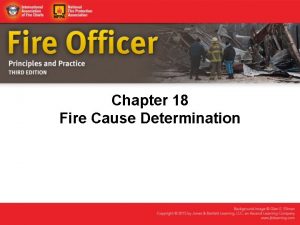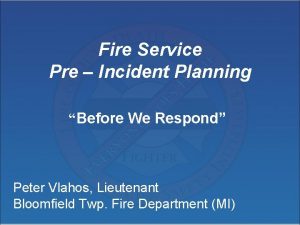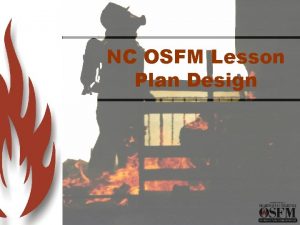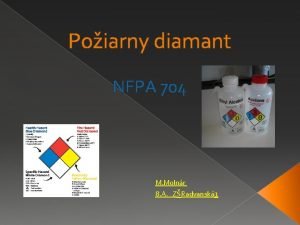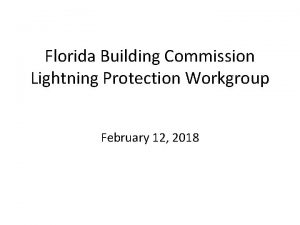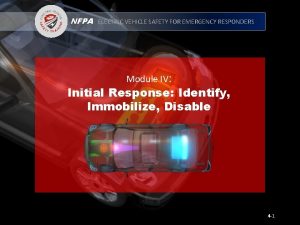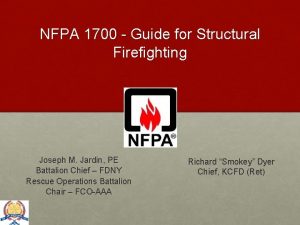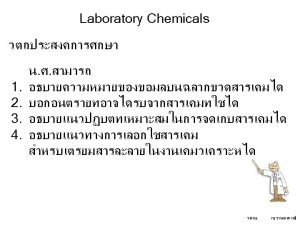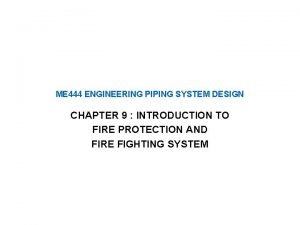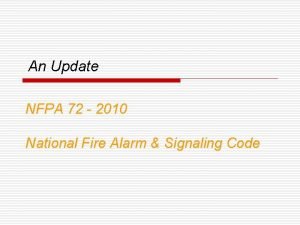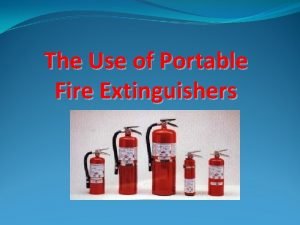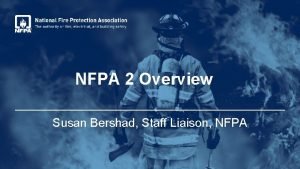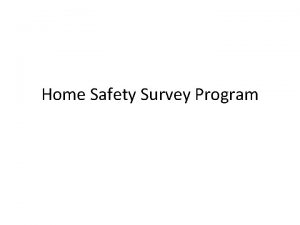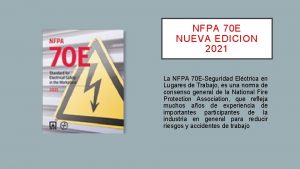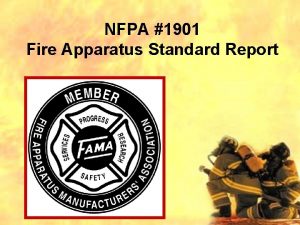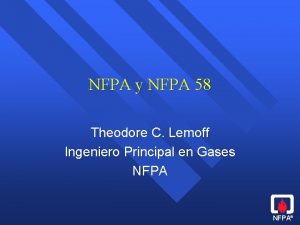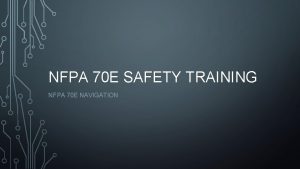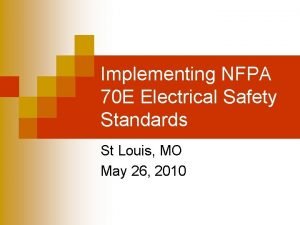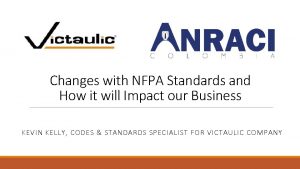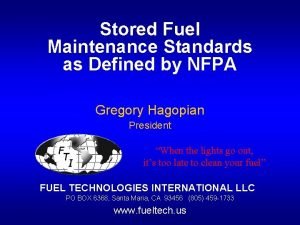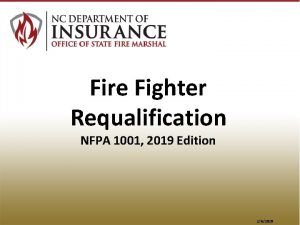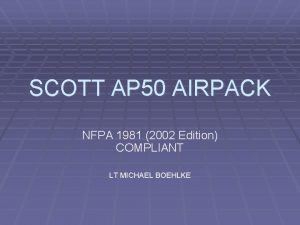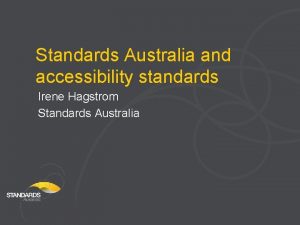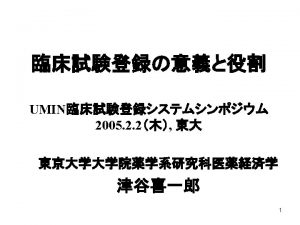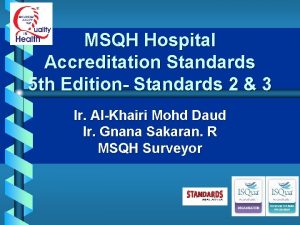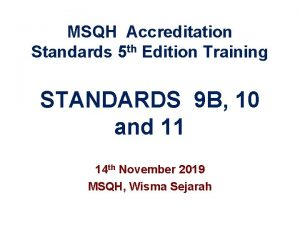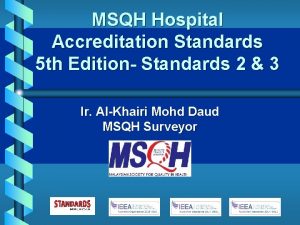OVERVIEW OF NFPA 70 E 2004 Edition Standards





























- Slides: 29

OVERVIEW OF NFPA 70 E (2004 Edition) Standards for Electrical Safety-Related Work Practice Requirements for Employee Workplaces Presented By: Steven Strayer, CIH, CSP, REHS, RS Cocciardi and Associates, Inc. (717) 766 -4500 (717) 766 -3999 (fax) sstrayer@cocciardi. com

Electrical Hazards • Shock – 1, 000 fatalities per year, >50% from <600 volts • Arc-flash – 35, 000 o F – 2, 000 severe burn cases per year – Kill out to 10 feet • Arc-blast – – Cu expands 67, 000 x’s from solid to gas Pressures = thousands of pounds per square feet Noise >160 d. B Molten shrapnel >700 mph

Occupational Safety and Health Administration (OSHA) • Worker protection police • General industry (1910) and construction (1926) • Subpart “S” – electrical – Methods to eliminate/minimize electrical hazards – Safe work practices (1910. 331 -335) – Training requirement (1910. 332) * Problem: Limited specificity (ex. Flash protection)

NFPA 70 E – Standard for Electrical Safety in the Workplace Background / History • Assist OSHA in developing workplace safety (NFPA 70 – NEC: Limited Application) • Four Parts to 70 E I. II. Installation Safety Requirements Now Chapter 4 (Articles 400 – 450) II. III. Safety Related Work Practices Now Chapter 1 (Articles 100 – 130) III. IV. Safety Related Maintenance Requirements Now Chapter 2 (Articles 200 – 250) IV. V. Safety Requirements for Special Equipment Now Chapter 3 (Articles 300 – 340)

History – • 1979: 1 st Edition (Part I Only) • 1981: 2 nd Edition (Added Part II) • 1983: 3 rd Edition (Added Part III) • 1988: 4 th Edition (Minor Revisions) • 1995: 5 th Edition (Revised Part I and II) • 2000: 6 th Edition (Revised Part II and Added IV) • 2004: 7 th Edition (Revised Title Format, and primarily Part II) • NEC format • Chapters/articles • Part II now Chapter 1

Scope – • Public and private premises including building, structures, mobile homes, RV’s, and floating buildings • Yards, lots, parking lots, carnivals, and industrial sub-stations • Installations used by electric utilities, such as offices, buildings, warehouses, garages, machine shops, recreational that are not an integral part of a generating plant, sub-station, or control station • Conductors that connect installations to a supply of electricity

Not Covered – • Installations in ships, watercraft, railway rolling stock, aircraft, or automotive vehicles other than mobile homes and RV’s • Installations underground in mines • Installation of railways • Installation of communication equipment (must be exclusive control of communication utilities) • Installation under exclusive control of electric utilities (service laterals/meters, rights-of-ways/easements, and property [owned or leased] for purpose of generation, transmission, transformation, etc. )

CHAPTER 1: Safety-Related Work Practices “On Hold For Further Examination”

Chapter 2: Safety Related Maintenance Requirements • Preserving or restoring the condition of electrical equipment and installations for employee safety. • Article 200 – Introduction • Article 205 – General Maintenance Requirements • Article 210 – Substations, Switchgear Assemblies, Switchboards, Panel Boards, Motor Control Centers, and Disconnect Switches • Article 215 – Premises Wiring • Article 220 – Controller Equipment • Article 225 – Fuses and Circuit Breakers • Article 230 – Rotating Equipment • Article 235 – Hazardous (Classified) Locations • Article 240 – Batteries and Battery Rooms • Article 245 – Portable Electric Tools and Equipment • Article 250 – Personal Safety and Protective Equipment (Inspections and Testing)

Chapter 3: Safety Requirements For Special Equipment • Special Equipment Includes: – – Article 300 – Introduction Article 310 – Electrolytic Cells Article 320 – Batteries/Battery Rooms Article 330 - Lasers

CHAPTER 4: INSTALLATION SAFETY REQUIREMENTS Based on NFPA 70 - NEC • Article 400 – General Requirements for Electrical Installations • Article 410 – Wiring Design and Protection • Article 420 – Wiring Methods, Components, and Equipment for General Use • Article 430 – Specific Purpose Equipment and Installations • Article 440 – Hazardous (Classified) Locations: Class I, II, and III, Divisions I and II, and Class I, Zones 0, I and II • Article 450 – Special Systems

Chapter 1: SRWP Article 100 – Definitions A. Qualified Person B. Unqualified Person C. Limited Approach Boundary D. Restricted Approach Boundary E. Prohibited Approach Boundary F. Flash Protection Boundary G. Energized Electrical Work/Electrically Safe Work Condition Article 110 – General • Practices/Procedures for employees working on or near energized conductors/circuit parts and unqualified individuals with other equipment Change – Multi-employer worksites – “Hazcom”

• Training – – Risk of electrical hazard not reduced to a safe level by Chapter 4 – Classroom/OTJ – Degree determined by risk – Include emergency procedures: First Aid/CPR, Methods of Release

• Qualified Persons – Precautionary Techniques – PPE – Insulating/Shielding Materials/Tools – Test Equipment – Distinguishing Live Parts – Determine Nominal/Voltage – Approach Distances – Hazard Evaluation (Including Non-electrical) – OJT personnel if under direct QP supervision

• Unqualified Persons – Awareness – Precautions – Hazards • Electrical Safety Program A. Provide awareness and self-discipline B. ID electrical safety principals – – – – – Inspect/evaluate Insulation and enclosure integrity Plan and document procedures Deenergize Anticipating the unexpected ID and minimize hazards Employee protection ID appropriate tools Personnel abilities Auditing

C. ID Electrical Safety Controls • Assumed “energized” • No bare-hand contact • Deenergizing procedures • Training • Equipment use for ID of hazards • Equipment training • Categorize tasks

D. ID procedures when working on >50 volts • Purpose • Qualifications • Hazard/extent of task • Limits of approach • Safe work practices • PPE • Insulating tools/materials • Special precautions • Diagrams/details/pictures • References

E. Hazard/risk evaluation procedures F. Job briefing(s) – each shift or more 1. G. Work Permit Procedures 2.

CHAPTER II – General Requirements For Electrical Work Practices • On/near exposed electric conductors • “Electrically safe” work conditions – Exceptions - 50 volts – Additional increased hazard – Operations or equipment design

Article 120 – Establishing On Electrically Safe Work Condition * Must follow LO/TO procedures and confirm (Test)* - Reference 29 CFR 1910. 147 Article 130 – Working On or Near Live Parts Change – A. Energized Electrical Work Permit - Circuit/equipment description - Justification - Safe work practices - Shock hazard analysis and boundaries - PPE - Documentation of job briefing - Authorization *Exception – - Voltage measurements - Testing - Troubleshooting B. Shock Hazard Analysis/Boundaries

• Approach Boundaries –Limited –Restricted –Prohibited

• Flash Hazard Analysis and Boundaries – 4 ft ( 600 volts and not greater than 300 k. A cycles) – Calculation of boundary (incident energy) for >600 volts • Boundary at 5 j/cm 2 (1. 2 cal/cm 2) – PPE – Conform to ANSI/ASTM criteria

“Hazard/Risk Category Classification” Table • Categories 1 – 4 (can be -1) PPE ranges from t-shirt/pants to flash suits and shields • Also addresses need for voltage rated gloves and tools • Clothing material Category “ 0” – natural fibers (weight >4. 5 oz/yd 2) (assume <2 cal/cm 2) Category “ 1” – flame resistant (4 cal/cm 2) Category “ 2” – “ 1” plus cotton underwear (8 cal/cm 2) Category “ 3” – “ 2” plus FR coveralls (25 cal/cm 2) Category “ 4” – “ 2” plus multi-layer flash suit (40 cal/cm 2) • Synthetics which melt below 600 o F

LIMITED APPROACH BOUNDARY • No unqualified persons, unless advised of hazards, escorted by QP • Conditions for qualified persons – Flash protection RESTRICTED APPROACH BOUNDARY • Qualified person: Do not cross or take a conductive object past, unless: – Person is insulated – Live part is insulated – Person is insulated from other conductive objects PROHIBITED APPROACH BOUNDARY • Qualified person – Only if body part is insulated

PERSONAL PROTECTION EQUIPMENT (PPE) • Conform to ANSI/ASTM Standards – Based on hazard/risk evaluations

• OTHER COMPONENTS: – Alertness – Blind reaching – Illumination: ANSI IES-RP-7 -1991 Generally 50 -100 foot candles depending on: – Age – Speed – Accuracy – Background Reflection – Conductive Articles

OTHER PROTECTIVE EQUIPMENT • • • Insulated tools (within Limited Approach Boundary) Ropes/handlines Grounding equipment/GFCI’s Ladders Rubber insulating equipment Physical/mechanical barriers: no closer than “Restricted Approach Boundary” Alerting • Signs/tags • Barricades • Attendants

USE OF SPECIFIC SAFETY RELATED EQUIPMENT AND WORK PRACTICES • • • Test instruments Energizing/de-energizing Portable electrical equipment Conductive work locations (GFCI’s) Connecting plugs LOCKOUT/TAGOUT PRACTICES AND DEVICES

 Nfpa 70e 2004 standard for electrical safety
Nfpa 70e 2004 standard for electrical safety Mis chapter 6
Mis chapter 6 Mis
Mis Customer service standards table
Customer service standards table Nfpa 1600 standard
Nfpa 1600 standard Nfpa 855 download
Nfpa 855 download Petroleum ether nfpa
Petroleum ether nfpa Nfpa tehlike işaretleme sistemine göre renkler
Nfpa tehlike işaretleme sistemine göre renkler Nfpa 1061
Nfpa 1061 Nfpa472
Nfpa472 Iso 11620
Iso 11620 Nfpa 99 leakage current limits
Nfpa 99 leakage current limits Passive purge fire sprinkler system
Passive purge fire sprinkler system Nfpa 1931
Nfpa 1931 Implementing nfpa 1600 national preparedness standard
Implementing nfpa 1600 national preparedness standard Nfpa 921 fire causes classifications
Nfpa 921 fire causes classifications Yakıcı yanıcı
Yakıcı yanıcı Nfpa pre incident planning
Nfpa pre incident planning Nfpa lesson plans
Nfpa lesson plans Nfpa diamant
Nfpa diamant Nfpa 1961 standard on fire hose
Nfpa 1961 standard on fire hose Nfpa 780 annex l
Nfpa 780 annex l Nfpa emergency field guide
Nfpa emergency field guide Joseph jardin fdny
Joseph jardin fdny Nfpa 5000
Nfpa 5000 ความอันตราย
ความอันตราย Me 444
Me 444 Nfpa 72-2010
Nfpa 72-2010 Limited approach boundary
Limited approach boundary Nfpa 10
Nfpa 10
